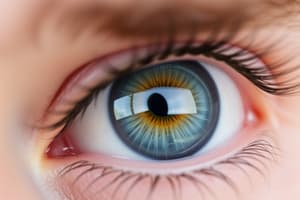Podcast
Questions and Answers
What is the main cause of hypermetropia?
What is the main cause of hypermetropia?
- The light entering the eye is focused in front of the retina
- The cornea having too much curvature
- The eyeball being too long (correct)
- The lens of the eye being too flexible
How does hypermetropia affect vision?
How does hypermetropia affect vision?
- It makes close objects appear clearer than distant objects
- It affects the color perception of the eye
- It causes blurry vision when viewing distant objects
- It leads to difficulty focusing on nearby objects (correct)
Which type of lens is used to correct hypermetropia?
Which type of lens is used to correct hypermetropia?
- Concave lens (correct)
- Prism lens
- Plano-concave lens
- Diverging lens
What optical defect causes hypermetropia?
What optical defect causes hypermetropia?
How does a converging lens help individuals with hypermetropia?
How does a converging lens help individuals with hypermetropia?
Flashcards are hidden until you start studying
Study Notes
Hypermetropia (Farsightedness)
- A common refractive error of the eye where distant objects are seen more clearly than nearby objects
- Light entering the eye is focused behind the retina instead of directly on it, causing blurred vision when looking at close objects
- Caused by either an eyeball that is too short or a cornea with too little curvature
Correction of Hypermetropia
- Can be corrected using a converging lens (convex lens) to help focus light rays properly onto the retina
- Allows individuals with hypermetropia to see nearby objects more clearly
- Power of the lens needed to correct hypermetropia depends on the severity of the condition
Studying That Suits You
Use AI to generate personalized quizzes and flashcards to suit your learning preferences.




